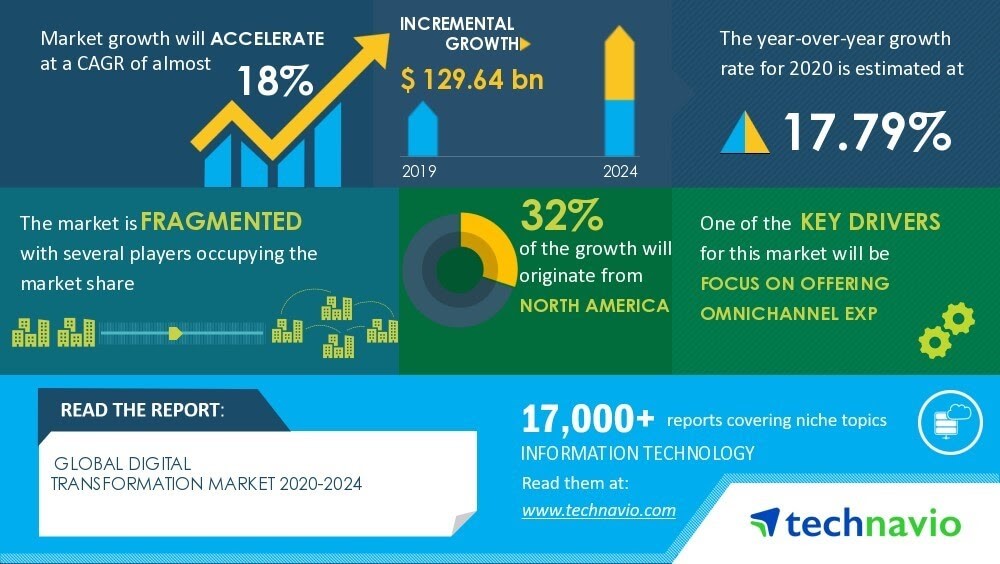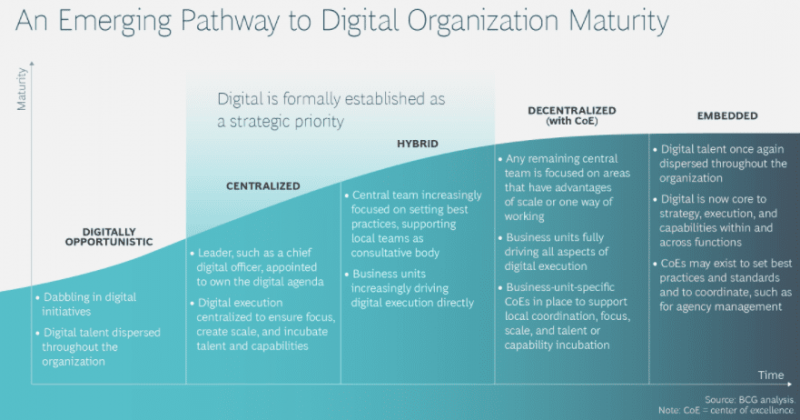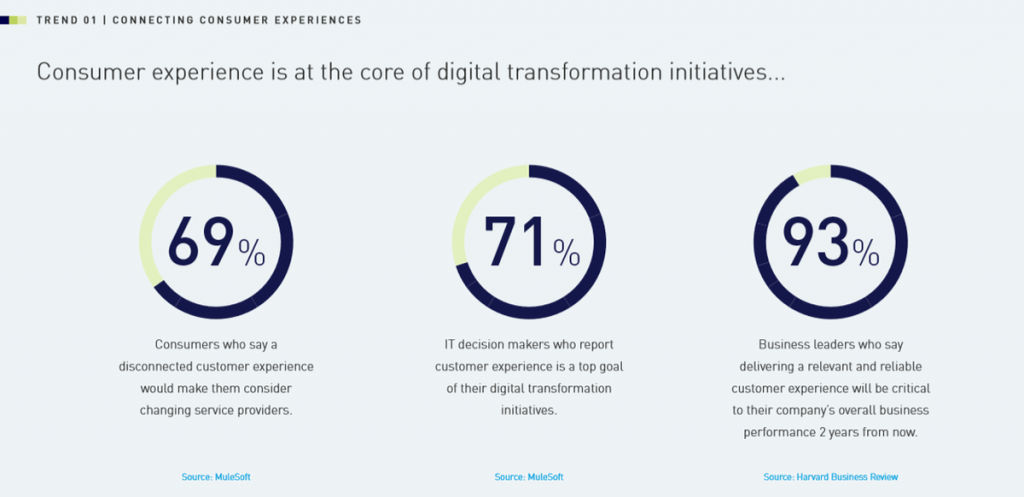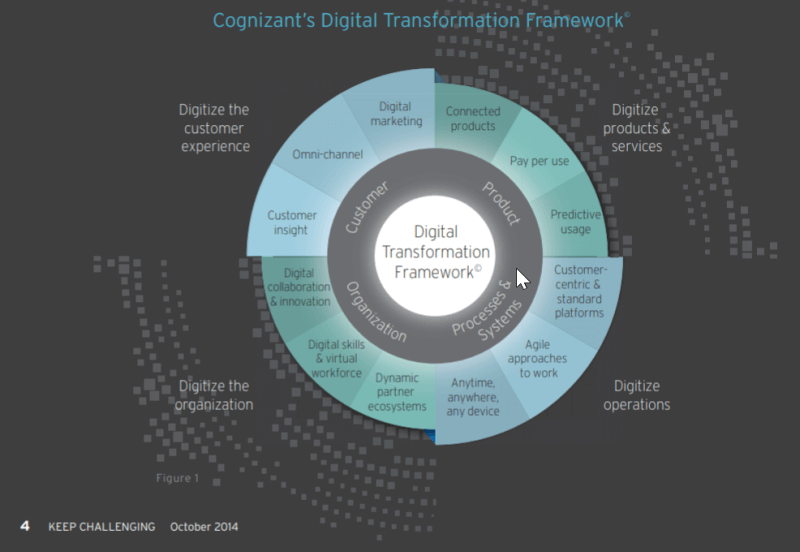Unlock Expert Advice with Zero Commitment.
We’ve Eliminated the Barriers.

“Change is the only constant” – Heraclitus’ words couldn’t have been more true than that in the case of the digital world. Live proof of this is Digital Transformation. Thanks to the rapidly evolving digital technologies, relevant updates to business are a necessity considering that all trades are looking ahead to set their foothold in the digital world.
With the targeted audience for all genres of trade leaning heavily towards the internet, this is an important move. Then again, the creation of a digital presence does not end the tale, it is but the beginning of it.
Business owners need to implement such alterations at a regular interval. That is what the basics of digital transformation comprise of. As for the rest of how, when, why, where, what is digital transformation strategy- take a look!
The pace of digital transformation varies vastly considering that it skyrockets at times, and at other times, merely, molasses. The direction of the trend-vectors is also unpredictable. However, it is here that various companies falter – they fail to understand this movement of the trends for digital transformation. For the ones who do, here are a few numbers showcasing some of some businesses –

The popularity of the transformation in the digital format is well reflected in these numbers. Needless to say, the benefits earned from the process are substantial, thereby the increased usage of these processes.

This brings us to the various aspects of the digital transformation process that would help them kickstart this process. Such informed decision-making ensures the complete success of the process. So, hop on to the train, get reading, and opt for some digital transformation consulting!
While some brands are still missing out on the full benefits of digital transformation by viewing it in a narrow concept, its benefits like the –

-can better be understood if they start to fathom out the types of it. This includes –
This aims to ensure the values that are delivered in the industry of the business that forms the fundamental blocks of any trade. The examples of this are well-established over the reinventions that stretch from –
Multiple efforts are still under process when it comes to transforming the business world into a robotic exercise, especially in the fields of mining.
With this, brands can stand at the doorway of new and innovative opportunities that boost their growth.
Digital transformations, in the long run, have a substantial impact on a brand’s capability, approach, and talent. These aspects are redefined and all that it requires-
Such companies initiate steps that would bring in alterations to their working. This type of digital transformation and the subsequent changes are a long-term requirement for success.
Brands, as of now, implement multiple technologies that include the automatic robotic process that aids in the streamlining of the back-office processes that include legal and accounting.
Such digital transformation holds certain values. These include adopting the latest technologies. This process is a speedy one, becoming table-stakes. Such changes are effectively focused around areas of business.
This is one area that is seldom focussed on but holds the potential for an immense opportunity. With blurred industry boundaries, redefined services, and products, the new technologies often fetch non-traditional brands.
Amazon has exploited this digital transformation type and definitely expanded the market domain to a substantial extent.
A review suggests that only a mere 23% of the brands are not yet relying on digital tools for their operations. The largely-written message of success via digital transformation has reached the ears of each of the companies, it seems. With predictions of increased spending on this transformation (CAGR growth of 16.7% from 2017 to 2022), multiple organizations are boosting their share of investment (from the capital budget) in the wish of gaining assured and higher returns via spiked revenue.
The ease of doing business, improvised customer experience, and lower churning

Quicker response time, improved efficiency, and reduced support costs.
Boosted engagement, improved efficiency, and lower employee turnover.
The framework for digital transformation is subjected to alteration based on the layout of the demands and challenges of an organization. However, there exist a few common themes and constants in the framework, irrelevant to the brand that adopts it. These are found amongst the published ad current case studies on these transformations. These cases are a mandate for those planning to adopt the transformation to ease in their started digital journey.

The primary framework for the digital transformation procedure is obviously the integration of various digital technologies. However, prior to the integration, brands need to shortlist the digital technologies that cater to their specific demands and requirements that will help them soar to the zenith of business-success.
Customers are always on the lookout for ‘instant coffee culture’-like quick and instant solutions. Thus, it is obvious that one of the core frameworks of the digital transformation process is customer experience. On the other hand, considering that customer experience is prioritized in the recent era, the dal advancements should also cater to the same.
With digital transformations, one of the major frameworks is that of workforce enablement. The integration of digital tools that cater to the company’s new goals ensures that the operational functions of a brand run smoothly. The employees gain benefit from the assistance of such technologies. Such technological aids help in offering better productivity that helps in better revenue generation for the organization.
Thanks to the growing competition among brands, it has become an essential part to adapt and evolve to the latest digital changes. This is a constant procedure and ensures that the brands in question are able to improve faster and strengthen their foothold in their trade genre.
This can well be explained by the fact that customers are no longer in need to physically visit organizations to carry out their business demands. These listed out requirements can be conveniently shifted from one department of the company to another, thereby completing the work efficiently.
Considering that the digital transformation framework is transparent for the brands, there are issues that they face, at times. One of such issues is understanding if the digital transformation has been appropriately implemented and if it has transformed their business, or not. Gauging this is convenient, only if one is well-acquainted with the core components of the process. This includes –
Look into your business process and check out the mode of business conduction. With a complete digital transformation, this mode will be subjected to a complete change bringing in a new process of operation. There will be no pause or flaws in the business transactions, only the mode of conducting business undergoes change. The expectation from the new model is that it will –
In this regard, you can take into consideration the EDI system that automatically transfers information from one trading partner to the other. This suggests that employees need not spend too much time in submitting and drafting the PO (Purchase Orders), making it efficient and less time-consuming.
Digital transformation requires a significant alteration in the business operations. Despite using the latest digital technology for creating products, it is not compulsory that the business has undergone a complete digital transformation. For the latter to be feasible, the operation process needs to be changed post the transformation.
To acknowledge the transformed operation process, let’s take into account the EDI systems again. This system offers a completely different operation procedure as in – this system notifies the organization of any delays or failures to submit the POS. This ensures that your brand remains aware of any such hurdles thereby the business remains agile and competitive.
With the great digital gamble in place, the organizations are looking to place their safe best. Needless to say, this gamble comes with minimum risks considering that these brands have a complete idea of what their company requires. These companies have become digital natives with reliance on updated technologies leading to a holistic digital transformation.
However, no matter how simple this sounds, it is not about flipping a switch to turn on the transformation. They need to bank upon the achieving of transformation via iterative steps to bring on an evolutionary process that strikes the sweet balance between the old and the new capabilities.
Brands need to understand that innovation and transformation are completely different. However, for transformation to be a successful procedure, there needs to innovation that will introduce the much-required touch of uniqueness to the organization. Such unique aspects can become incremental overtime that is potent enough to boost customer experience.
However, there is a point to be noted in this case. Some introduced innovations are colossal and are responsible to alter the business model entirely. While others are minute and only make significant differences to tune the customer experience. They also differentiate the product or service offering in the market.
Such introduction of digital innovation is instrumental in improvising the digital transformation procedure. Creativity creates an open space to allow convenient problem-solving when it comes to facing challenges. For the innovation angle, brands need to make sure that they have possession of collaboration, open communication, and the freedom to bring in creativity.
In this regard, the empowering of a brand requires three core capabilities that comprise of –
Needless to say, the inclusion of digital technology in any business requires complete financial support from its stakeholders. Really, it is essential to create a persistent experience for the –
-that aids people achieve their business objectives, irrespective of the location that they work from, and the genre of trade that they deal in. This becomes one of the most crucial factors to meet the digital expectations of clients.
The major target is to ensure that the customers get the required help to fulfill their business goals. These –
Although customer experience is a primary focus for businesses, they cannot consider merely this single aspect to meet the demands of the mobility of enterprises. Subsequently, they will be able to offer location and device-independent access to the information infrastructure and current process of the brand in question.
Thereby, it is essential to fathom out that it is the connectedness and mobility of users which is instrumental in unlocking the digital values, and the devices.
In this respect, the true mobility of enterprises requires a few capabilities, three of the most important ones are –
Catering to the digital theme of the age, patience is not much of a virtue. Clients are not much patience towards slow processing, delivering changes in applications and technologies. Along the same lines, brands seeking to
-require to deliver their web-scale IT at a pace that matches up the digital speed. Such brands must have an outward-facing team. This team would
-innovative ways to interact via diverse means that include –
Consequently, this brings in new models of business to offer what suits the works best.
The creation of any true business model that is digital-reliant needs the usage of digital platforms that cater to the new digital pace of businesses and supports innovation at its best. Brands can use the boosted IT industrialization as a leverage to create end-to-end modeling. This –
To accelerate business transformations, there are three capabilities that need to be taken care of –
Digital pros are of the belief that web-enabled connections among devices, individuals, and systems are potent enough to transform the existing business models and therefore, create better versions of the same.
This is where multiple organizations falter – they lay their entire focus on the digital front-end; whereas they should be emphasizing the end-to-end connectivity for the process.
Thus, brands should be creating an end-to-end flow of processes that optimizes the fulfillment of connected experiences. All that they would need to do is –
Therefore, this pillar of digital transformation calls for a crucial skill – have the ability to keep on extending and evolving the chain of digital supply, keeping pace with the evolving suppliers, clients, and partners.
A true change of process, in this respect, needs 2 crucial capabilities that include –
By now, readers have numerous reasons to adapt to the new digital transformation process that is subjected to alterations over regular intervals of time. Considering that you are looking to list out modern approaches to boost your business, you cannot afford to miss out on digital transformation. Considering that the ‘why’, ‘when’, and ‘what ‘of adapting digital transformation is clear, now is the time to look into the ‘how’ of the topic – the digital transformation strategy.
Gauge the degree of digitization of the brand in question. Try and align the existing short and long term digital goals of the company. This is crucial because each of the enterprises has their
Put out a clean goal and build a plausible game plan . these would include selected regions for the improvement of the brand and start the integration of chosen digital systems from such regions.
A successful digital transformation process entails enablers like –
This step requires enterprises to fathom out the enabler that would cater to their digital goals. All that they need to do is analyze and research the topic and find the one that is best suited for them.
Post-digital transformation projects can be expected to undergo significant changes. Sans the support of an appropriate leader, carrying out the project efficiently, and within the preset time frame becomes a genuine hurdle.
In this regard, it serves better if there is a CIO, supported by a strong leader-led team. Furthermore, it also helps if the digital transformation of businesses as KPI exists. This sets the margin between a successful and unsuccessful digital transformation fro enterprises.
A crucial part of digital transformation is educating and training the staff across organizations. Such staff adapts to multiple alterations conveniently over time and each of the processes in firms is operating agile.
Without the much-required cultural changes, brands would be missing out on the upcoming revolution in the world of technology. This would be followed by a wasted effort and time-consumed to catch up with the said technological advancement.
This brings us to three crucial cultural changes that are deemed essential for the business benefits of digital transformation process. These include –
Know this – the best practice for digital transformation include –
True that technology is core to the digital transformation procedure, it is inclusive of technology, but not conclusive to it. The perfect, final dish would need a sprinkle of culture and dash of talent that transforms an enterprise into its best digital version. In the throes of digital transformation, it is essential that the project leads need to keep their calm and dive into its sea.
You would need to fathom out how such a transformation procedure affects business and end-users as well. It is crucial that the enterprises keep a watch on the digital horizon considering that the future of the digital transformation procedure looks bright and impressive.
Have a question about digitally transforming your product? Get in touch!
We’ve Eliminated the Barriers.
We stand by our work, and you will too.